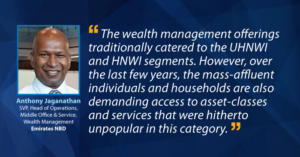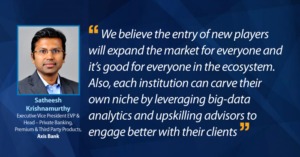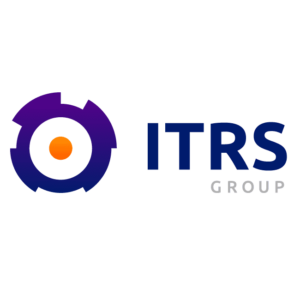Wealth Management – A significant opportunity beckons
Increasing clients per advisor and better advisory to each client – striking two birds with one stone
Industry at a leapfrog moment.
In 2019, the average wealth-per-adult reached a new record high of USD 70,850. About 1% of global adults are millionaires; they collectively hold 44% of global wealth. The number of affluent individuals (with assets of $250,000 to $1 million) is also increasing steadily; about 4 million new individuals are joining this group each year.
Wind in the sails.
An increase in the number of wealthy individuals is driving growth in the total investible assets around the world. Amidst these tailwinds, the wealth advisory departments continue to be a lucrative business for financial institutions. In 2018, the revenues were a record high of $694,000 per advisor in the USA. The fact that the biggest wealth management departments (by assets managed) happen to be closely related (if not subsidiaries & internal departments) to financial institutions with a long operational history. It seems like the incumbent financial institutions continue to be the trusted financial advisors and wealth managers for the global wealthy. However, their trust and continued patronage are likely to be put to test in the near future.

Rise of the new-age customers & competition.
In addition to the growing numbers in the ultra-high net-worth individuals (UHNWI) group, the great wealth transfer – the anticipated passing-on of $30 trillion in wealth from the elders to their younger heirs over the next few years, is poised to be a watershed moment for financial planners and wealth managers. The new-age investors tend to be generally tech-savvy, data driven, and well-informed about economic scenarios and opportunities. They are known to demand full-transparency, faster service, access to a full spectrum of products, and greater personalization of advisory and services.
While addressing the renewed customer expectation in the new decade, the incumbents must also compete with the new-age specialist investment firms. These FinTechs, with their digital-only propositions, are offering their platform and services (nearly) free of cost. While one may doubt their long-term profitability and viability, their ability to disrupt the established order of business cannot be ignored.
Wearing the strategic hat of versatility
It is obvious that each investor comes with a different set of needs and expectations. And, profitability-at-scale can be achieved only when the advisors and relationship managers can increase the number of clients and further grow the total asset under management (AUM). So, the question is ‘how to add new clients, whilst ensuring deeper engagement with each one of them at the same time.’
To address this conundrum, the forward-looking financial institutions are leveraging technology to create a digital platform capable of delivering omnichannel experiences for customers, data-driven insights for advisors, and automation of back-office operations. Such a platform will be vital to scaling the client-base, offer a broad set of products (across asset classes) and deliver on the promise of speed and convenience.
Improving customer experience (CX).
It is widely acknowledged that CX innovation helps in engaging and retaining customers. It is also a valuable differentiator between the financial institutions to earn customer loyalty. The CX reimagination usually includes a channel (often, a mobile app) for clients to monitor their portfolio of banking accounts, investment portfolios, and real-time valuations of their assets and liabilities.
Boosting advisor productivity.
Financial institutions must strive to empower their financial advisors with digital tools to understand their clients better, anticipate their needs, and offer quality-advice quickly. The platform must also unburden them of the repetitive and administrative tasks, so they can focus on advisory services. The digital dashboard (usually, an application accessible from a tablet or a laptop) must help advisors to manage and interact with their clients better. It must support common tasks such as risk-evaluation, client onboarding, portfolio monitoring, performance alerts, deviation notifications, portfolio rebalancing and reporting. The dashboard must also facilitate easy communication and collaboration between advisors and their clients, facilitate document management, schedule meetings, take notes and accelerate the process of approval management.
Streamlining front to back office operations.
Businesses today run at a fast pace. Financial institutions must embrace digitization and automation to step-up the overall efficiency of their wealth management offerings. The effective digitization of key back-office tasks like order management, transaction reconciliation, product cataloging, and commission calculation is key to providing a seamless CX for the clients.
Making the smart moves.
 While technology can unlock new possibilities and accelerate the business transformation, the vision and strategy to drive it will differentiate the industry-leaders from the laggards. Various institutions are pursuing innovative initiatives to defend their clientele and growing their revenues further.
While technology can unlock new possibilities and accelerate the business transformation, the vision and strategy to drive it will differentiate the industry-leaders from the laggards. Various institutions are pursuing innovative initiatives to defend their clientele and growing their revenues further.
A popular strategy is to expand to an emerging customer-segment. Speaking about this trend at a recently organized webinar, Mr. Anthony Jaganathan, Senior Vice President, Head of Operations, Wealth Management at Emirates NBD opined that, “the wealth management offerings traditionally catered to the UHNWI and HNWI segments. However, over the last few years, the mass-affluent individuals and households are also demanding access to asset-classes and services that were hitherto unpopular in this category”. This democratization of access to wealth management services seems to be a universal demand and it’ll serve the incumbent institutions well to explore this opportunity expeditiously.
 Another growth-hack is to bundle wealth products with premium banking services so that customers get an integrated experience. Axis Bank, a leading private bank in India, has found emphatic success with this go-to-market approach. In the context of entry of new-age competition, Mr. Satheesh Krishnamurthy, Executive Vice President EVP & Head – Private Banking, Premium & Third Party Products, Axis Bank said, “we believe the entry of new players will expand the market for everyone and it’s good for everyone in the ecosystem. Also, each institution can carve their own niche by leveraging big-data analytics and upskilling advisors to engage better with their clients”.
Another growth-hack is to bundle wealth products with premium banking services so that customers get an integrated experience. Axis Bank, a leading private bank in India, has found emphatic success with this go-to-market approach. In the context of entry of new-age competition, Mr. Satheesh Krishnamurthy, Executive Vice President EVP & Head – Private Banking, Premium & Third Party Products, Axis Bank said, “we believe the entry of new players will expand the market for everyone and it’s good for everyone in the ecosystem. Also, each institution can carve their own niche by leveraging big-data analytics and upskilling advisors to engage better with their clients”.
In the face of the changing business landscape and emerging opportunities, it needs to be seen how soon and how well the incumbent financial institutions adapt to the new-normal or concede ground to the new-age and specialist players. Either way, exciting times lie ahead.
****************************
An article by Abhra Roy, Product Head – Wealth Management, Infosys Finacle
Sources:
• Global wealth report 2019, Credit Suisse
• Great Wealth Transfer, Forbes









